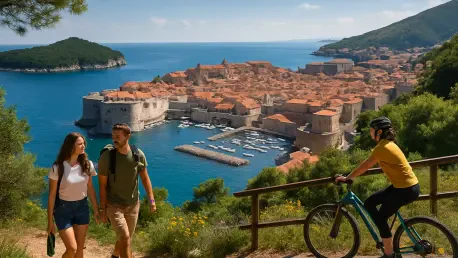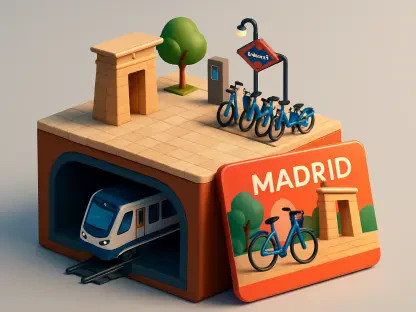Imagine a historic city so breathtaking that its medieval walls and cobblestone streets draw millions of visitors each year, yet this very allure threatens to erase the essence of its community. Dubrovnik, a gem on Croatia’s Adriatic coast, faces precisely this challenge as overtourism strains its cultural heritage and disrupts residents’ daily lives. With visitor numbers once soaring unchecked, the city has become a case study in balancing tourism’s economic benefits with the urgent need to preserve a livable environment. This guide delves into the innovative best practices Dubrovnik has adopted to combat overtourism, offering actionable insights for other destinations grappling with similar issues. By prioritizing sustainability over sheer volume, the city sets a compelling example of how to protect both heritage and humanity amidst global travel pressures.
The Importance of Sustainable Tourism in Dubrovnik
Sustainable tourism has emerged as a cornerstone for Dubrovnik’s survival, shifting the focus from mass influxes to meaningful, quality-driven experiences. This approach counters the risks of cultural erosion and resident displacement that unchecked tourism can bring, ensuring that the city remains a vibrant home rather than a hollow attraction. By embracing sustainability, Dubrovnik aims to safeguard its UNESCO-listed medieval core while maintaining the authenticity that draws travelers in the first place. The emphasis on fewer, more engaged visitors helps reduce wear on historic sites and fosters a deeper connection to local traditions.
Beyond preservation, this shift offers tangible benefits for both residents and tourists. For locals, it means reclaiming public spaces and improving quality of life, free from the constant crush of crowds. For visitors, it translates to richer, less rushed encounters with the city’s history and people, enhancing satisfaction over superficial sightseeing. These changes underscore a broader vision of tourism as a partnership rather than an imposition, prioritizing long-term well-being over short-term gains.
Dubrovnik’s efforts also carry global significance, serving as a potential blueprint for other tourist-heavy regions. Cities worldwide face similar dilemmas, where economic reliance on tourism clashes with cultural and social sustainability. By demonstrating that controlled growth can yield positive outcomes, Dubrovnik challenges the conventional wisdom of endless expansion, inspiring a reevaluation of how destinations define success in the travel industry.
Key Strategies to Combat Overtourism in Dubrovnik
Dubrovnik has implemented a multifaceted array of strategies to manage tourist numbers while fostering a sustainable environment. These initiatives are not mere stopgaps but carefully designed policies aimed at reshaping the city’s relationship with tourism. From regulating cruise ship arrivals to leveraging technology for crowd control, each measure reflects a commitment to balance and innovation.
One standout aspect is the city’s focus on data-driven solutions and community involvement, ensuring that policies are responsive to real-time needs and local priorities. The following sections break down these strategies, providing detailed insights into their implementation and impact. Supported by measurable outcomes, these practices offer a roadmap for mitigating overtourism’s challenges effectively.
Cruise Ship Restrictions and Economic Contributions
A pivotal strategy in Dubrovnik’s arsenal is the strict limitation on cruise ship arrivals, capping them at two per day with a mandatory minimum docking time of eight hours. This policy stands in stark contrast to earlier peaks when up to eight ships would dock daily, often for brief, rushed visits that contributed little to the local economy. By enforcing longer stays, the city encourages passengers to explore beyond quick photo stops, ensuring more substantial spending at local businesses like restaurants and shops.
This regulation has reshaped the economic landscape for small enterprises that previously struggled with the transient nature of cruise visitors. Longer docking periods allow for deeper engagement, boosting revenue for vendors and service providers who rely on tourism as a livelihood. The policy strikes a balance between welcoming visitors and preventing the overwhelming surges that once clogged the city’s narrow streets.
Visitor Monitoring and Dubrovnik Pass Innovations
Technology plays a critical role in Dubrovnik’s efforts to manage tourist flow, with CCTV cameras providing real-time crowd monitoring across key areas. This system helps officials identify congestion hotspots and respond swiftly to prevent bottlenecks. Complementing this is the Dubrovnik Pass, a digital tool that streamlines access to major attractions like museums and city walls while collecting valuable data on visitor patterns.
Looking ahead, the city plans to enhance this system with time-slot bookings for popular sites, allowing travelers to plan visits during less crowded periods. A traffic light system will further guide tourists toward quieter times and locations, distributing foot traffic more evenly. These innovations aim to reduce stress on high-demand areas, ensuring a smoother experience without sacrificing accessibility.
Community-Centric Policies and Urban Revitalization
Beyond managing numbers, Dubrovnik has introduced policies to prioritize its residents, addressing the displacement caused by overtourism. Regulations on short-term rentals curb the conversion of homes into tourist accommodations, preserving housing for locals. Simultaneously, the city has taken bold steps to acquire old town buildings, offering them as affordable rentals to young families to encourage repopulation of the historic center.
Another transformative initiative is the repurposing of historic structures for community use, such as converting a former palace into a school. This move not only preserves architectural heritage but also breathes new life into the urban core by attracting families and fostering a sense of belonging. Such efforts underscore a commitment to making the city a place to live, not just visit.
Conclusion: Evaluating Dubrovnik’s Path Forward
Reflecting on Dubrovnik’s journey, the city’s anti-overtourism measures have proven both ambitious and challenging, balancing immediate economic trade-offs with lasting cultural preservation. The cruise ship restrictions, technological innovations, and community-focused policies marked a significant departure from unchecked tourism growth, setting a precedent for sustainable practices. Despite initial financial hurdles for some local stakeholders, the long-term vision of a livable, vibrant city began to take shape, benefiting residents and mindful travelers alike.
Moving forward, other destinations could draw inspiration by adopting a phased approach, starting with data collection to understand visitor impacts and engaging communities in policy design. Patience emerged as a critical factor, as did the willingness to prioritize quality over quantity in tourism metrics. Global cooperation also played a vital role, suggesting that cities should collaborate on shared challenges like pricing adjustments and crowd management tools to amplify their impact.
Ultimately, the focus should remain on creating authentic experiences that honor a destination’s identity while ensuring residents thrive. Dubrovnik’s experience highlighted that success lies in adaptive, inclusive strategies tailored to local needs. For any city embarking on this path, the next step involves building robust stakeholder dialogue and investing in scalable solutions that can evolve with tourism’s changing landscape.









